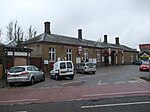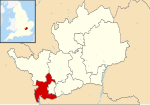Stocker's Lake
Geography of Three Rivers DistrictHerts and Middlesex Wildlife Trust reservesLocal Nature Reserves in HertfordshireRickmansworth

Stocker's Lake is an old flooded gravel pit of approx 90 acres (37.5ha) at Rickmansworth, Hertfordshire, England, within the Colne Valley Regional Park which is designated as a Local Nature Reserve.The lake is owned by Affinity Water and managed by the Herts and Middlesex Wildlife Trust assisted by the Friends of Stocker's Lake.
Excerpt from the Wikipedia article Stocker's Lake (License: CC BY-SA 3.0, Authors, Images).Stocker's Lake
Springwell Lane, London
Geographical coordinates (GPS) Address Nearby Places Show on map
Geographical coordinates (GPS)
| Latitude | Longitude |
|---|---|
| N 51.63 ° | E -0.488 ° |
Address
Springwell Lane
WD3 8UZ London (London Borough of Hillingdon)
England, United Kingdom
Open on Google Maps







